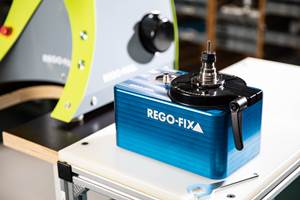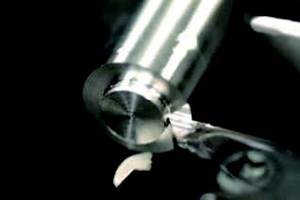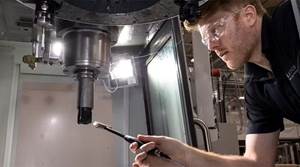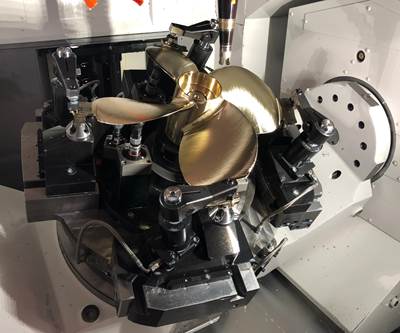A Study Of The Steady Rest
When the length and stiffness of a workpiece make it difficult to machine, many turn to the steady rest.
Share





When the length and stiffness of a workpiece make it difficult to machine without distorting or deflecting the part, many manufacturers turn to the steady rest as a workpiece support device. This is especially true for long axles, shafts and similar parts used in automotive or heavy equipment applications, and in oil drilling components. The most common application is to support a workpiece during turning or milling and, increasingly, during secondary operations such as ID drilling, boring and producing end face bolthole patterns.
Edward J. Peter of LNS America, Inc. (Cincinnati, Ohio) has more than 27 years of experience in the application and design of steady rests. He offers the following points to consider when selecting the appropriate steady rest:
1. Structural attributes
Be certain the materials used and the overall design ensure precise, reliable performance. For example, the arms must be wide and sturdy enough to properly support the workpiece but also allow ample tool clearance.
2. Manual versus automatic positioning
A manual steady rest requires individual adjusting of each point that contacts a workpiece. Automatic steady rests are self-centering and use hydraulics or pneumatics to clamp and unclamp parts. These systems have integrated cylinders that may be actuated by machine control M codes or by manually operated switches.
3. Size
The steady rests must fit in the machine without interfering with the doors, cross-slide cutting tools and sheet metal guards. Some suppliers can provide custom designs and configurations, such as narrow arms and side mounted cylinders, that permit additional clearance in the machine tool.
4. Lubrication
An automatic lubricating system is generally a better long-term solution than a manual system. Make sure the lubrication system is programmable and capable of lubricating all working parts, including the roller bearings, at recommended intervals.
5. Protection against contamination
Look for a pressurized, sealed construction that keeps harmful contaminants out. Some steady rests offer additional protection through an integrated inlet that allows air pressure to purge impurities from the unit.
6. Applications expertise
Determining the size, placement and number of steady rests is critical. An experienced supplier can help. The key factors to consider are part length, weight, diameter, material composition and the kind of machining operations being performed.
7. Design integration
Design software with 3D modeling capability allows a supplier to design a system that combines the steady rest, automatic clamp base, brackets, tubing, valves, hose track assemblies, electrical connections to the machine control and even way covers if required.
8. Mounting
It is important to mount the steady rest for maximum machining efficiency. It is also critical to consider part loading and unloading, how the rest will affect the operating range of the machine tool and if custom way covers or other modifications are needed. Common machine tool mounting locations include:
- Tailstock ways (traditional boxed style ways or newer linear ways)
- Cross slide
- Lower turret of a four-axis machine (fixed, or using a rotary coupling to allow remaining tool positions to be used)
9. Special considerations for machines with linear ways
The steady rest brackets and bases must be mounted on bearing blocks that fit the machine tool’s existing linear rails, and there must be a manual or automatic method devised to clamp the brackets and bases to the linear rails after they are moved into position. In a manual installation, the operator moves the steady rest and then uses a switch to hydraulically clamp the workpiece. An automatic system uses M codes to locate the steady rest and hydraulically clamp the base to the rail. When installing a steady rest on a linear way machine, the original equipment guards may need to be modified, and it is often necessary to create telescoping way covers to protect the linear rails and the machine tool ballscrew.
10. Safety
To safeguard the operator and the machine, designers may use positioning switches, pressure switches, timers, sensors and machine control interfaces.
Related Content
Five Common Mistakes Shops Make with ER Collets (And How to Prevent Them)
Collets play a crucial role in the machining process, so proper tool assembly and maintenance is important. Here are five potential pitfalls to avoid when using ER collets.
Read MoreToolpath Improves Chip Management for Swiss-Type Lathes
This simple change to a Swiss-type turning machine’s toolpath can dramatically improve its ability to manage chips.
Read MoreOrthopedic Event Discusses Manufacturing Strategies
At the seminar, representatives from multiple companies discussed strategies for making orthopedic devices accurately and efficiently.
Read MoreHow to Mitigate Chatter to Boost Machining Rates
There are usually better solutions to chatter than just reducing the feed rate. Through vibration analysis, the chatter problem can be solved, enabling much higher metal removal rates, better quality and longer tool life.
Read MoreRead Next
Sometimes the Trickiest Part of CNC Machining Is Holding the Part
Finding a way to fixture contoured marine propellors proved to be this shop’s biggest challenge in developing an effective automated machining cell.
Read MoreAMRs Are Moving Into Manufacturing: 4 Considerations for Implementation
AMRs can provide a flexible, easy-to-use automation platform so long as manufacturers choose a suitable task and prepare their facilities.
Read MoreMachine Shop MBA
Making Chips and 91ÊÓƵÍøÕ¾ÎÛ are teaming up for a new podcast series called Machine Shop MBA—designed to help manufacturers measure their success against the industry’s best. Through the lens of the Top Shops benchmarking program, the series explores the KPIs that set high-performing shops apart, from machine utilization and first-pass yield to employee engagement and revenue per employee.
Read More























